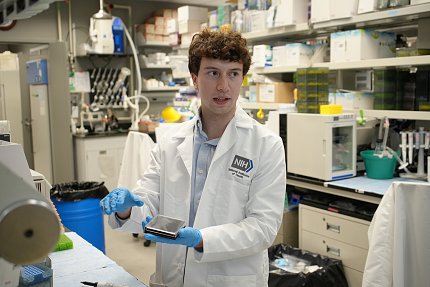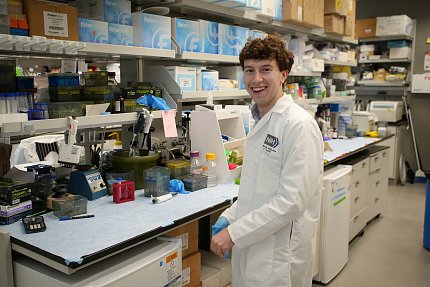Reputation Matters
Summer Fellow King Chose NIH for Internship Opportunity
For Charles “Sam” King, a rising senior at Purdue University majoring in pharmaceutical sciences, the decision about where to work over the summer was influenced by numerous recommendations from friends and mentors.

Photo: Eric Bock
The consensus was clear: NIH offered exceptional training opportunities for undergraduate students. With its well-respected programs, diverse research areas and cohort of experts at the top of their fields, NIH became the top choice for King’s summer internship.
In early June, King began working in the molecular neuropharmacology section under Dr. David Sibley, a senior investigator at the National Institute of Neurological Disorders and Stroke. The opportunity to work in-person has been invaluable.
“I wouldn’t do this internship if it wasn’t in person,” King said, expressing admiration for NIH’s esteemed reputation and its commitment to cutting-edge research. He emphasized that the hands-on experience and collaborative atmosphere have significantly enhanced his learning and professional growth.
Prior to joining NIH, he gained valuable experience working at a startup biotech company called Babson Diagnostics in his hometown of Austin, Tex. There, he conducted blood draws from patient’s fingers using an innovative device developed by the company.
Last summer, he further honed his skills at the Mayo Clinic, where he investigated how a drug named ICRF-193 causes DNA-damage. During the academic year, he studies how epigenetics affects cancer progression.
King spends a typical day at NIH focused on the study of dopamine receptors (DARs). There are five DARs in the human brain—D1 through D5. The goal of his research project is to aid development of a new D3 DAR (D3R)-selective small molecule that may one day be a research tool compound or medication for diseases such as schizophrenia and substance use disorder.
Many neuropsychiatric disorders are treated with dopamine antagonists, or drugs that block DARs. The current medications of choice are D2-like DAR antagonists. But due to limited distribution of D3R in the brain, D3R-selective antagonists may be better treatments for schizophrenia or drug addiction because they could reduce psychotic symptoms or drug cravings without inducing some of the serious side effects often produced by D2R-preferring antagonists.

Photo: Eric Bock
In his research King utilizes Chinese hamster ovary cells to detect DAR activation and inhibition. He uses live cells because he needs the “full cellular machinery” to detect whether the compounds he is screening can activate or inhibit any of the other DARs aside from D3R. King employs these cells in an assay that generates a measurable chemiluminescent signal upon DAR activation. Compounds that act as agonists at the DARs will increase the signal, and compounds that act as antagonists will decrease a signal induced by an agonist, such as dopamine.
In addition to his lab work, King attends lectures in the Clinical Center to broaden his knowledge and experience interdisciplinary perspectives. Reflecting on his expectations versus the reality of working at NIH, King expressed awe at the vastness and scale of the institution.
“I think the biggest shock was how big it is,” he said. The wealth of resources available and the interdisciplinary nature of the work have exceeded his initial expectations.
Looking to the future, King has ambitious plans. He is currently applying to M.D.-Ph.D. programs, which he hopes will enable him to bridge the gap between bench science and clinical practice.
